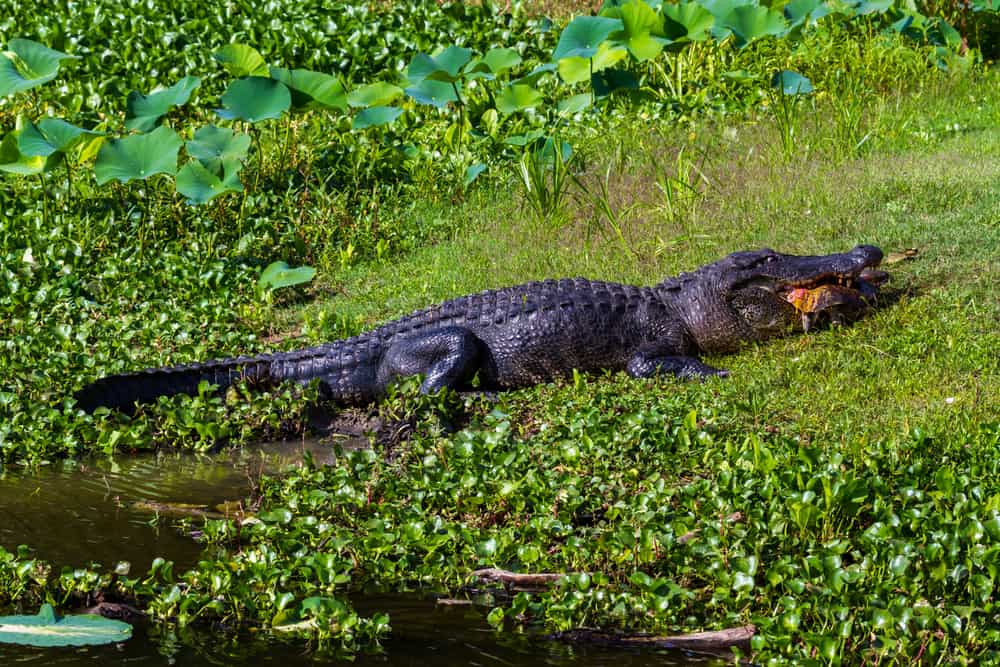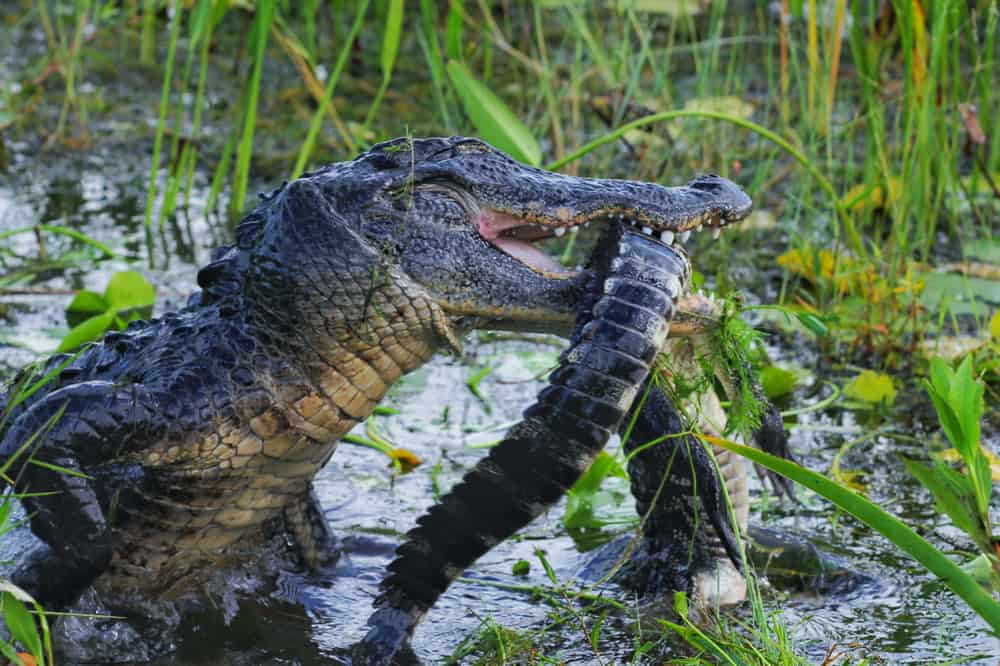You can recognize two alligator types. The American alligator lives in the southeastern US, while its Chinese cousin inhabits eastern China. Both have blunt and broad snouts but significantly differ in size.
Nowadays, the American alligator has managed to recover as species, while the Chinese alligator is on the verge of extinction. Both are cold-tolerant but don’t enjoy saltwater because of the lack of salt-excreting glands. Many people are not sure what do alligators eat and whether they can indeed swallow people. Let’s see.
Alligators Habits and Biology
The term alligator comes from el Lagarto, the Spanish word for lizards. Nowadays, there are only two gator types living worldwide:
American alligator
This large lizard prefers freshwater habitats in the US Southeast, including:
- North Carolina
- Oklahoma
- Arkansas
- Florida
- Texas
However, this species is tolerant to partly salty waters (brackish) like tidal marshes.
It is a hefty animal. Females are typically 9 feet (2.75 m) long and about 200 pounds (91 kg) heavy. Males (bulls) can reach 13 feet (4 m) in length and can weigh 500 to 1,000 pounds (227 – 453.5 kg).
Chinese alligator
This lizard is the only member of the Alligatoridae family that lives outside the Americas. Previously, this species lived near the Yangtze River, but its habitat nowadays is restricted to approximately 2 square miles (5 km2).
In fact, you can sporadically find these animals only in Anhui Province. It is considered highly endangered, but Chinese authorities claim that the species is recovering thanks to numerous concrete moves to save it.
It typically grows to 5 feet (1.5 m), but some males can reach 7 feet (2 m). Most are under 50 pounds (23 kg) heavy, but some animals can weigh up to 85 pounds (38.5 kg).
Alligator types |
||
| Scientific classification | American alligator | Chinese alligator |
| Kingdom | Animalia | Animalia |
| Phylum | Chordata | Chordata |
| Class | Reptilia | Reptilia |
| Order | Crocodilia | Crocodilia |
| Family | Alligatoridae | Alligatoridae |
| Subfamily | Alligatorinae | Alligatorinae |
| Genus | Alligator | Alligator |
| Species | Alligator mississippiensis | Alligator sinensis |
It is a crucial species thanks to the habit of digging burrows in the mud with its tails. The alligator only wants to use such a hole to keep warm and for nesting, but abandoned burrows filled with freshwater allow other species to drink and undisturbed breeding after gators leave. Removing this lizard from the ecosystem would negatively affect other species.
What Do Alligators Eat in the Wild?
American alligator
American alligators are carnivores that are not picky eaters. They can even consume fruit besides their favorite meat. It is impressive seeing a gator using its sharp teeth to capture prey. Thanks to the powerful jaws, this lizard can effortlessly crack even a turtle’s shell.
Alligators are lurkers that hunt predominantly at night and use eyes, ears, and skin sensors to detect an animal entering the water. They will wait for prey in water with the eyes and nostrils above the water surface and then grab it with incredible speed.
Once the gator captures large prey, it will drag it underwater and drown it before devouring it. Thanks to its glottis, an adaptation in the throat, this animal can capture prey while submerging in water.
As all other opportunistic feeders, alligators will choose easily accessible species in their habitats. This hunter will even use a powerful, 7 to 7.5 feet (2 – 2.3 m) long tail to jump up to 5 feet (1.5 m) out of the water to catch a victim.
Since alligators are cold-blooded animals, they don’t need to eat often. It is enough to feed once a week, but it primarily depends on the season.
Their metabolism slows down during winter when a brumation period begins. In that time, gators are in a deep-season sleep and don’t eat regularly.
Moreover, these lizards have one remarkable trait. Their body can store excess calories in fat deposits located at the tail base, so an alligator can survive up to two years by burning fat reserves without feeding.
American alligator consumes a wide prey variety, including:
- Insects
- Muskrats and nutria
- Frogs
- Turtles and snakes
- Horseshoe crabs
- Small fish
- Stingrays and small sharks
- Large birds, often waterfowl
- Beaver
- Raccoons
- White-tailed deer
- Feral pigs
It is recorded that alligators living in Florida grabbed and ate:
- Watchdogs
- Black bears
- Panthers
Unlike a crocodile, an alligator attacks humans only when feeling life-threatening. It will typically go away after seeing a human being and attack only when someone provokes it or in self-defense.
Chinese alligator
Chinese alligators are predators and carnivores that actively hunt for food. Since they belong to the group of opportunistic feeders, you can expect them to eat everything they find along the waterways where they live. Their teeth are blunt, flat, and slightly rounded, so this lizard can effortlessly crush prey.
Since this animal lives in lakes, ponds, and floodplain backwaters, they feed on:
- Snails and worms
- Mussels and clams
- Fish
- Rodents, including mice and rats
- Young waterfowl, like ducks
- Small mammals
- Fruit when it is available
- Carcasses when necessary
Hatchlings
Hatchlings’ diets consist of small animals, like:
- Insects
- Crawfish
- Frogs
- Small fish
5 Facts About Alligators
American alligator vs. crocodile
Even though alligators and crocodiles are similar to most people, they are actually pretty different. Most crocodiles are larger and heftier than alligators, including the 23 feet (7 m) long giant saltwater crocodile.
Thanks to sharp and pointed teeth designed for tearing, crocodiles have a powerful bite with a bite strength of 3,700 PSI. On the other hand, alligators use their jaws for crushing prey, and their cone-shaped teeth allow a bite strength of ‘only’ 2,500 PSI.
American alligator vs. crocodile |
||
| Trait | Alligator | Crocodile |
| Habitat | Most southeast states | Florida |
| Length | 9 to 13 feet (2.75 – 4 m) | 17 feet (5 m) |
| Weight | 200 to 1,000 pounds
(91 – 453.5 kg) |
800 to 1,000 pounds
(363 – 453.5 kg) |
| Color | Black, dark green | Light gray, light green, brown |
| Snout shape | U (rounded) | V (triangular) |
| Teeth | Only top teeth are visible | Five bottom teeth are visible |
Since alligators can live in colder regions, the large lizard you notice out of Florida is probably a gator. They are active at temperatures up to 80 F (26.7 C) and become dormant during the cold period of the year.
American alligator biology
American alligators start reproducing once they are 10 to 12 years old. After mating, the female builds a nest in shallow water and lays up to 90 eggs at once.
After 65 days of incubating, young alligators let their mother know it is time for hatching by making a high-pitched noise from the eggs’ inside. Unfortunately, hatchlings are often prey to predators, including:
- Snakes
- Birds
- Some fish
- Mammals
Once a hatchling reaches 4 feet (1.2 m) long, it is safe without many predators in nature. Most alligators live about 50 years in the wild.
Chinese alligator biology
The Chinese alligator is polygamous, so males breed with more females. Their social life starts before hatching since nestmates can communicate egg to egg. Hatchlings typically spend a few weeks or sometimes years together under their mom’s protection.
Mating begins in early summer when females are mature and at least five years old. Two to three weeks later, they build nests for 25 to 45 eggs. Hatchings begin their lives in September.
You can see these lizards digging extensive earthen tunnels with numerous entrances and chambers, where they spend most of the day, particularly during the winter months. They will emerge from winter burrows in April.
Chinese alligator usually lives about 50 years in nature and up to 70 years in captivity. In such a case, it is common to reproduce in their 50s.
Biting force
When an alligator catches too large prey and can’t swallow it at once, it will store leftovers underwater, probably under a tree root or log. Once the meat starts rotting, it will become soft, and the gator will effortlessly tear off chunks. Believe it or not, these lizards often swallow stones to make diving deep quicker.
An alligator has about 80 teeth that can regrow after falling out. Once this predator catches its prey, there are almost non-existent chances of escape. Its biting force is enormous so that this animal can smash a hard turtle’s shell or mammal bone in one move.
Conservation status
American alligators were on the edge of extinction by the 1960s because of intense hunting. They were highly appreciated for their meat and hides.
Thanks to conservation efforts, their number has significantly increased in the last decades. Scientists consider this species entirely recovered since a few millions of these lizards inhabit the Southeast.
Chinese alligators are probably the world’s most endangered crocodilians. Pollution, overhunting, and massive habitat loss resulted in only 100 or even fewer animals remaining in the wild.
Summary
For alligators, hunting is a dynamic process. They can feel any prey movement in the water thanks to their sharp eyesight and specific sensory organs over the skin.
Once they spot a victim, they launch an attack, drag prey underwater, and drown it before consumption. In some cases, you can see these reptiles using sticks to attract nesting birds. It is pretty impressive, isn’t it?

